However, weather strips that combine a seal (often a rubber bulb or foam gasket) and a wood stop moulding work well for old houses, as they marry modern technology and traditional millwork.
Windows may be weather-stripped with many of the same products used for doors. Spring bronze is still one of the best for retrofitting double-hung sash windows. It can be installed without removing the sash, and it’s hidden when the window is closed. Nail-on foam and felt types will work on double-hung windows, but since the strips must be applied where sash and trim meet, they are obvious.
Before installing weather stripping, repair any door, window, or trim defects. Weather strips alone can’t address cracks more than 1/8” wide. Before you install, read the recommendations and instructions from the manufacturer of the type you choose.
DOORS: SPRING & V-STRIP
Nailing spring strip at a window. Rob Leanna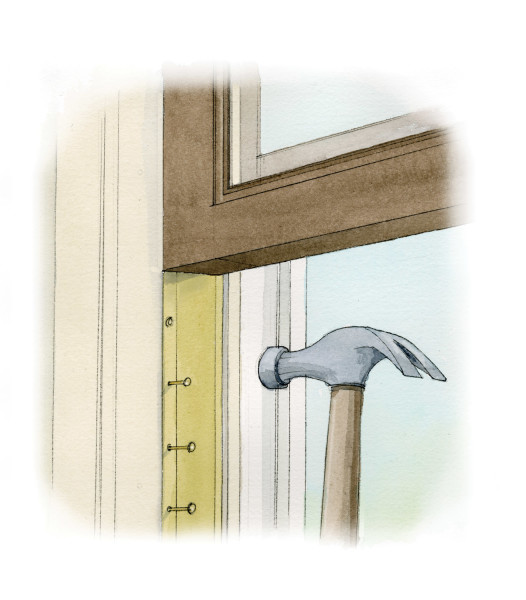
Try to match the door’s dimensions when you buy—e.g., 1 1/4″ width for 1 3/4″ exterior doors. Some dimensions are not available at everyday hardware outlets. Metal weather strips are attached to the jamb with copper weather-stripping nails. Install spring bronze with the nailing edge facing away from the door stop; with V-strip, the nailing strip runs next to the stop. For the length, measure from the threshold to the upper corner where the jamb meets the head. When nailing the weather strip, avoid wrinkles, which will let in the elements. Start with the hinge side and center the material on the jamb, flange to the outside. Leave a 1/16” space below the doorway header at the top. Keeping the strip absolutely straight, drive a nail near the top, middle, and bottom hinges. Next, tack the strip to the jamb until all nails are 1 1/2″ apart, and drive the nails flush with a nailset.
For the opposite jamb, install the lock strip so it extends 3/4″ past the top and bottom of the lock strikes. Use three or four nails to anchor the strip to the stop. Cut a piece to reach from the header to just past the screw of the deadbolt keep. Tack this strip near the top and middle. Cut a notch to create a tab that fits under the lock strip, and trim the nail edge at 45 degrees to get rid of the sharp point. Do the same from the bottom of the lock to the threshold. If there’s space between the lock boxes, cut a third strip in this fashion on both ends. For the header, cut a slight bevel on the ends so it doesn’t interfere with the two pieces it meets in the corners. At bottom corners, secure a piece of felt to seal between the weather stripping and the threshold. If the weather strip needs to be pulled out, run a dull screwdriver tip or a 5-in-1 tool along the crease in the metal.
Installing spring strip on a door jamb. Rob Leanna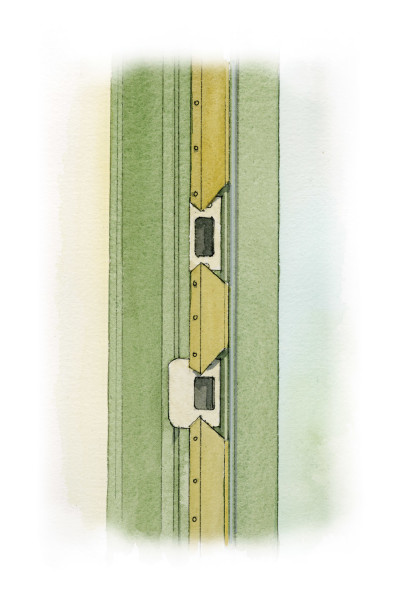
DOORS: STOP-AND-SEAL
Stop-and-seal combinations are lengths of metal or wood moulding fitted with a weather strip, which attach to a door jamb in place (or on top) of the existing stop moulding. Wood versions look best on old houses, and may be purchased as stock units, or custom made using kerf-in seals. Select a product of sufficient size and resilience to create an effective seal. Install it as you would a standard door stop, mitering at corners and scribing at the threshold according to the existing trim. A good way to position the seal: 1. Close the door tightly against the bolt; 2. mark the jamb with the width of stop-and-seal, measuring back from door; and 3. position the stop just inside this line. If screws are installed, the stop will be adjustable.
WINDOWS: WEATHER STRIPPING
Marking for a stop & seal. Rob Leanna
To install spring-metal strips on double-hung windows, leave the upper sash fully closed, and open the bottom sash halfway. Measure the sash channel from its bottom to the top of the lower rail of the upper sash, and cut two strips this length, using tinsnips. Now open the bottom sash all the way and insert one end of a strip into the sash channel, between the window frame and the lower sash, with the nailing edge snugly along the inside edge of the sash channel. Tack the strip along this edge, nailing every 3″. Then pry out the free side of the metal strip with a dull screwdriver or a 5-in-1 tool, so it springs nicely against the edge of the sash. Repeat for the other side and the upper sash. Carefully maneuver the strip into place around sash cords, and trim the metal where it passes the sash cord pulleys.
To install top and bottom strips, measure the lengths, cut strips to size, and nail them in place with the nailing edge facing the room. Finally, with the upper sash lowered and the lower sash raised above it, cut a third horizontal strip and nail it in place along the outside face of the lower-sash meeting rail. Orient this strip with the nailing edge down so that it pulls against its mate and is hidden from inside view when the window is open.
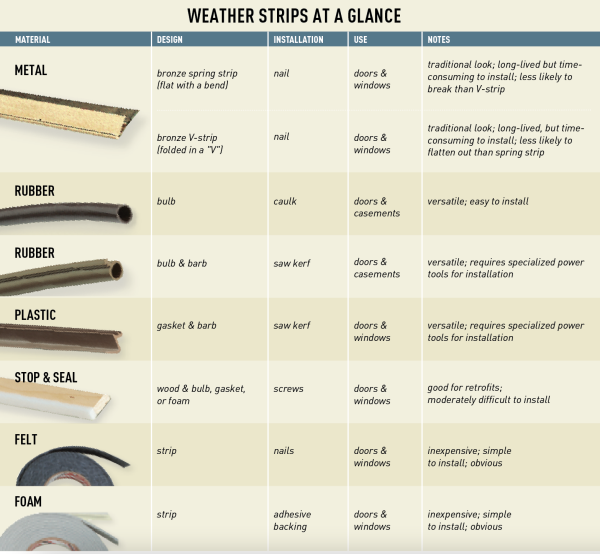
If your old house has wooden casement windows, use spring bronze weather stripping and install much as you would for a door. Assuming the window opens outward, orient the nailing edge of the strip toward the outer edge, so the window pulls snugly into the spring. Trim the weather strip around the hinges. If your casement windows are steel, look into vinyl gasket strips made with a groove that allows them to slip over the frame edge. Corners are cut with a razor knife and secured with adhesive. When the window closes, it pulls into this strip, creating a seal.
Installing metal strip at upper jamb. Rob Leanna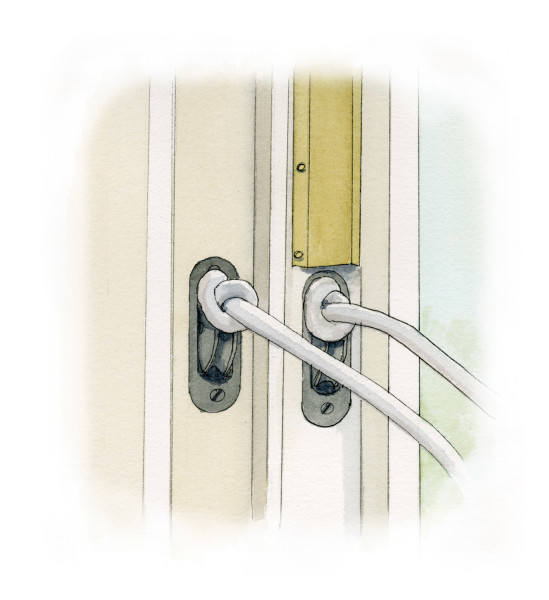
DOOR SWEEPS AND BOTTOM SEALS
These are two good options for weather-stripping the bottom of an exterior door, a major spot for infiltration and heat loss. Most of these products come with nylon brushes or rubber seals, which can be replaced as they wear.
Door sweeps are cut to length, and fastened with screws at the bottom of the door on the side that faces the inside; a seal is thus made between the rubber of the sweep and the threshold. Some designs must be screwed on both sides of the door.
Door sweep. Rob Leanna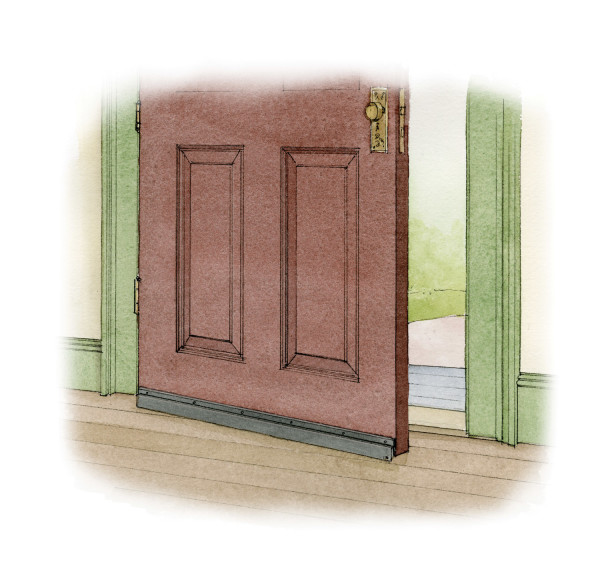
Bottom seals go underneath, directly into a door’s bottom edge, most often into a cut groove or rabbet. The door has to be removed to install a bottom seal, but it’s very effective—and invisible.
Sealing gaps around doors and windows is the goal, whatever the type. As a bonus, weather stripping also cuts down on rattling. Original or old weather stripping is likely to be of the spring or V-bronze variety, which have been in production for years and last a long time. Self-adhesive rolls of foam or plastic are inexpensive and easy to use, but neither durable nor historic. Nail-on strips (e.g., felt) must be installed along the jamb against the perimeter of the door and are therefore distractingly obvious.
Weatherstripping Resources
• Accurate Metal Weatherstrip Door saddles, interlocking weather strips, spring-type, door sweeps
• Conservation Technology All types of retrofit weather-seals for millwork and metal, door bottom/casement seals, gasketing, related products
• Grainger Window and door seals, door sweeps,bottom seals, foam tape
• M-D Building Products Door seals, weather strips, garage-door seals, backer rods, A/C covers, etc.
• Pemco/Assa Abloy search for online sellers | Full spectrum of weather stripping & sealing products
• Swisco Replacement Hardware Bubble seal, door strips, flexible vinyl window strips, door sweeps (plus balances, casement operators, etc.)







